Sabih with spiced chickpeas
Sabih with spiced chickpeas
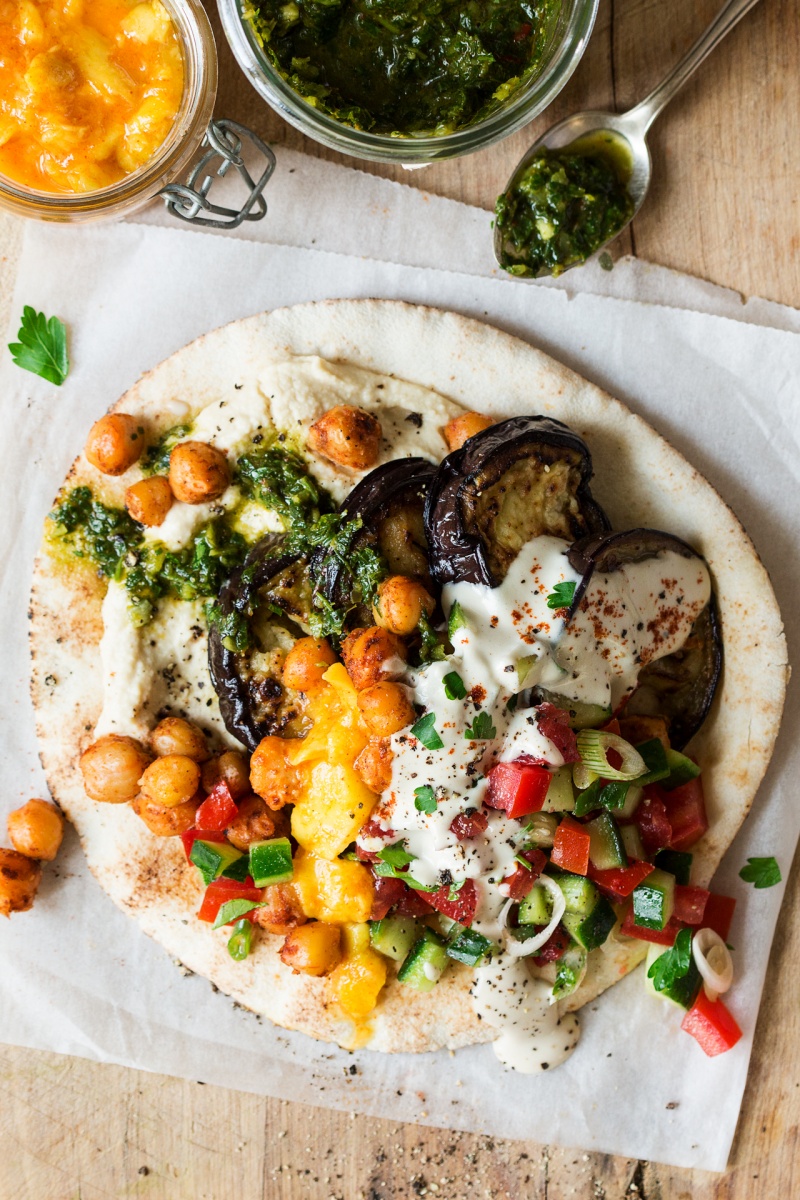
I’ve been ogling sabih in Yotam Ottolenghi’s book Jerusalem for a while now, but I was missing some ingredients and so I never got round to making it.
Then a few weeks ago I got a message from one of my readers (I cannot believe anyone reads my stream of consciousness 😉 ), Golan, who was visiting Paros. Duncan and I met up for coffee with him and his partner, Danny, and that meeting put a big simile on my face. They were both very nice and easy to talk to and they were into good food so we had plenty to talk about. They were also so kind that they brought me a huge jar of delicious tahini straight from Israel. I can easily get tahini here, but the one I got from them was so much more delicate and creamier than any of the Greek ones I’ve tried. Frankly, I am happy to eat it with a spoon with a touch of maple syrup or pomegranate molasses mixed in. So now that I have this luscious tahini and the savoury mango pickle, which I managed to get my hands on while in Athens, I’ve had to put both of them to a good use, quick! My thoughts turned to a sabih…
To me, this sandwich feels like such a perfect metaphor for Israeli food. Each group of Israeli immigrants brought something to the table – fried aubergine and hard boiled egg (which I substituted with spicy chickpeas), came from Iraqi immigrants. Fragrant, herbaceous and very spicy zhoug sauce, which Ottolenghi explains as Middle-Eastern ketchup, was brought by Yemenite Jews. Salty and vinegary mango pickle was also introduced by Iraqi Jews but it is derived from Indian cuisine, with its classic flavours of mango, turmeric, mustard and fenugreek. Finally, a simple chopped salad (a version of which is found pretty much everywhere around the Mediterranean Sea) and tahini sauce are Israeli staples.
This melting pot of a sandwich is a bit of revelation in my books. The simple components come together in a meal bursting with flavour! It’s so easy to make too! Granted, it does require quite a few ingredients and processes, BUT you can make pretty much each component in advance and assemble the sandwich on each day of the week. There are so many palate-tingling flavours in there that you won’t get bored.
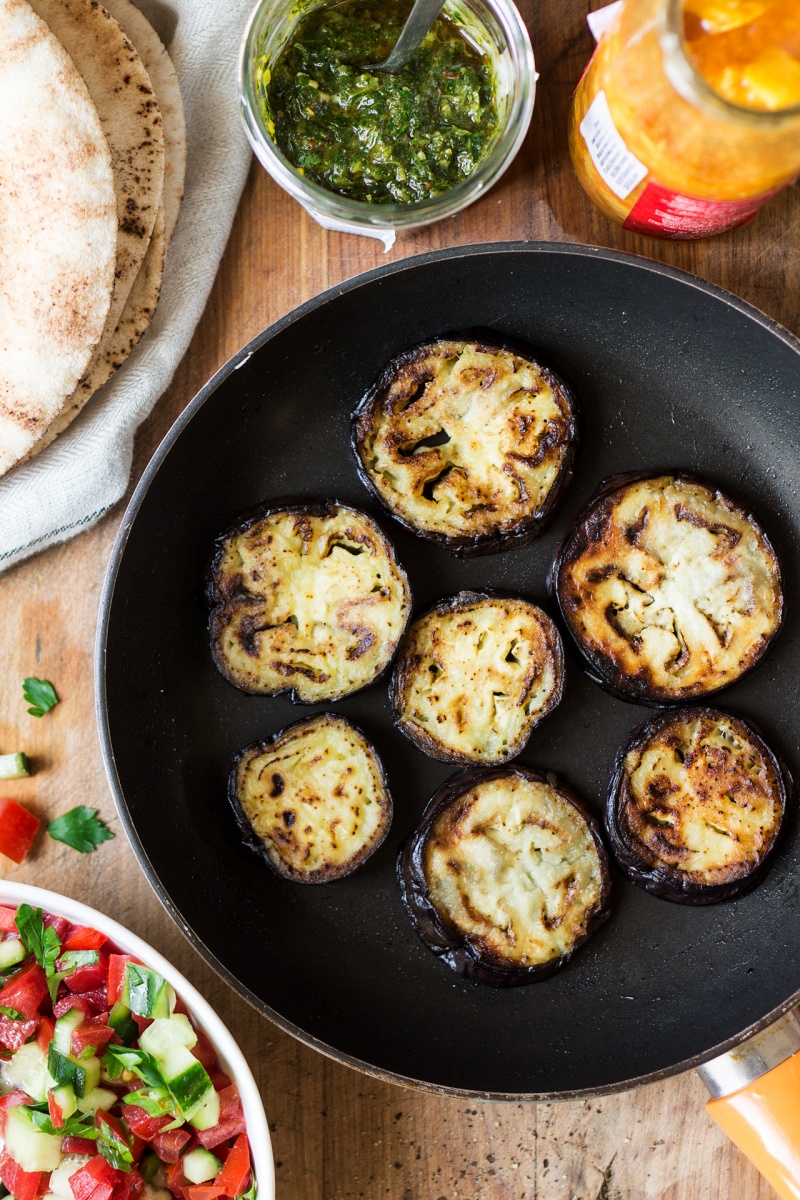
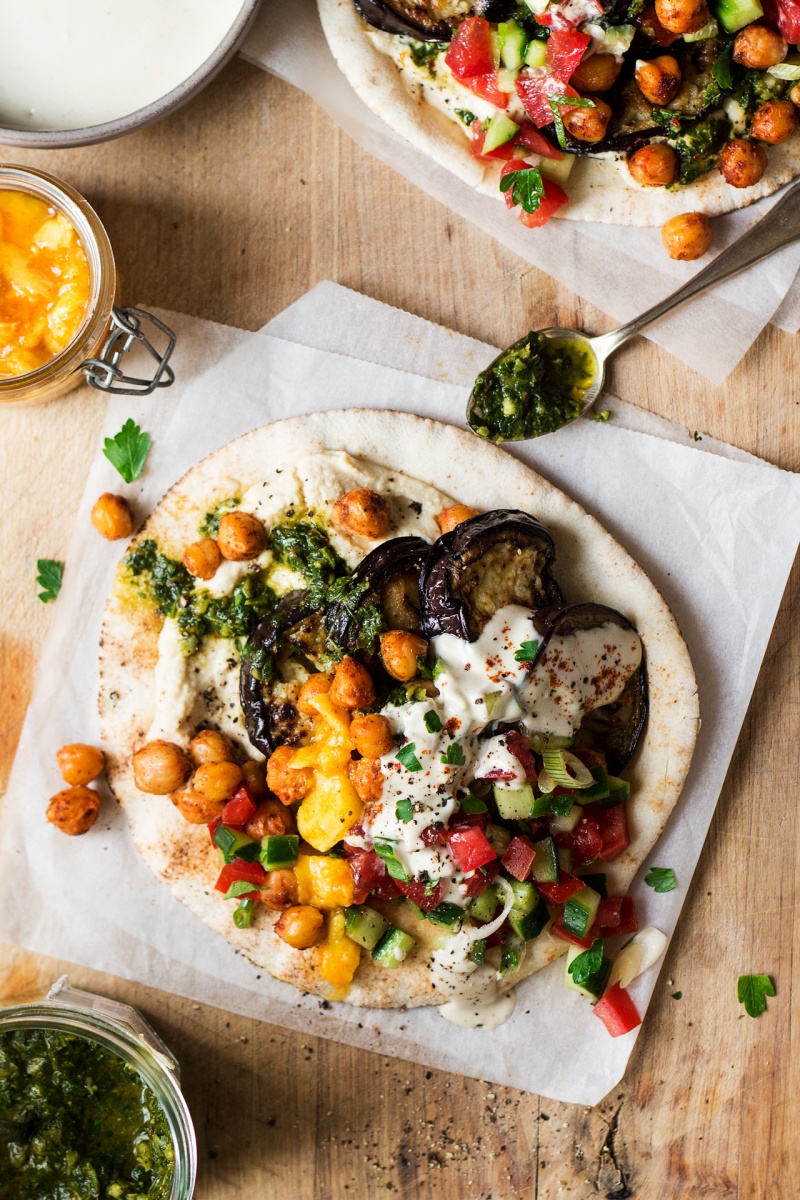
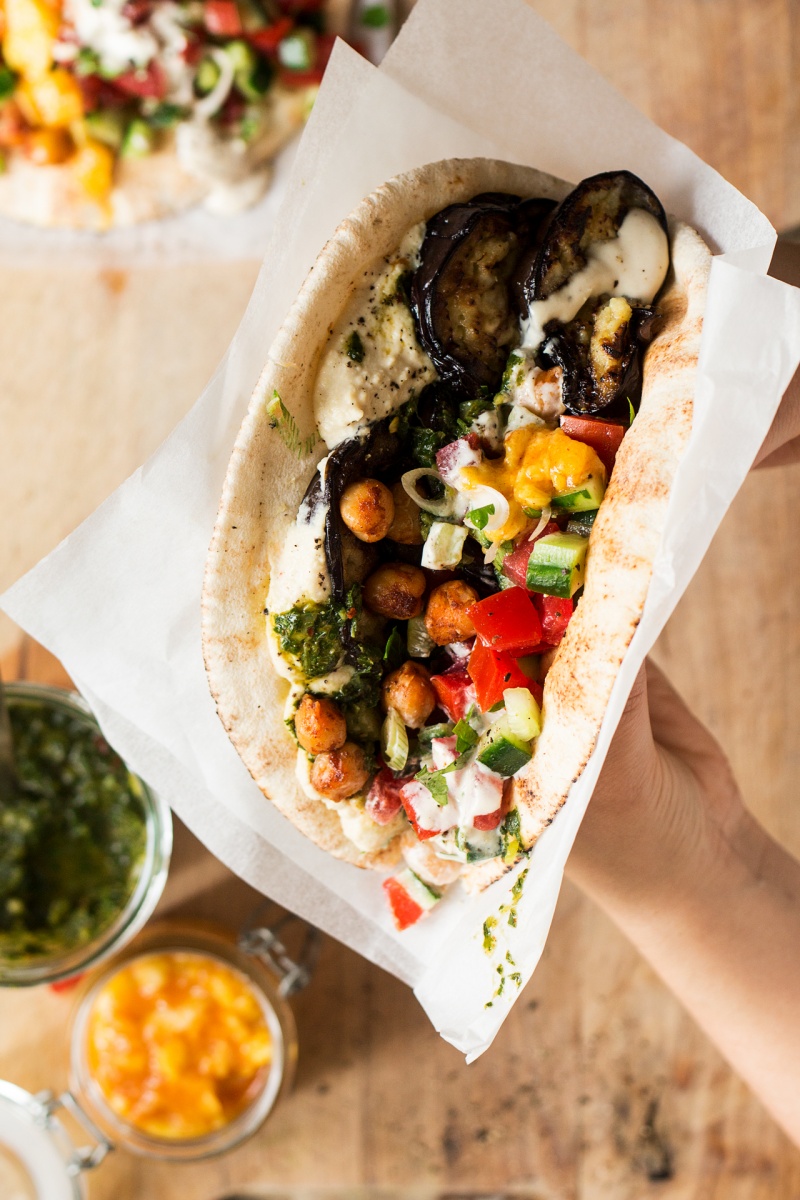
- olive oil
- 2 small aubergines / eggplants
- 2 tsp fine salt
- 3 tsp cornstarch / cornflour (optional)
SPICY CHICKPEAS
- 2 cups cooked chickpeas, drained well
- 2 tbsp olive oil
- 1 tsp cumin
- 1 tsp smoked paprika
- ½ tsp chilli powder, adjust to taste
- fine sea salt, to taste
ZHOUG (spicy herb condiment)
- 35 g / 1 cup packed fresh coriander leaves
- 20 g / ½ cup packed fresh parsley leaves
- 1-2 hot green chillies
- ½ tsp ground cumin
- ¼ tsp ground cardamom
- ¼ tsp ground cloves
- a pinch of sugar
- ½ tsp salt
- black pepper, to taste
- 4 tbsp extra virgin olive oil
- 2 tbsp lemon juice
- 2 tbsp water
TAHINI SAUCE
- 60 ml / 4 tbsp tahini
- 2 tbsp lemon juice
- ½ large garlic clove, grated
- 1 tsp maple syrup
- salt & pepper, to taste
ISRAELI SALAD
- 1 Lebanese cucumber
- 2 ripe tomatoes
- 1 medium spring onion, sliced
- a few stalks of parsley, chopped finely
- 1 tbsp extra virgin olive oil
- lemon juice, to taste
REMAINING INGREDIENTS
- savoury mango pickle (also known as amba)
- 4 round pitas (GF if necessary)
- classic hummus (recipe here), optional
- Cut aubergines into 2.5 cm / 1″ slices. Sprinkle with salt on both sides and set aside for 30 minutes for any excess moisture and bitterness to go.
- After 30 minutes, wipe the salt off with a piece of kitchen towel. Blot the slices on the kitchen towel until completely dry.
- Heat up a medium non-stick pan with 1 tbsp of oil. Meanwhile, sprinkle the first batch of sliced aubergine with a thin layer of cornstarch – this is optional and not a traditional thing to do, but it minimises the amount of oil the aubergine soaks up during frying and gives it a nice, delicately, crispy texture on the outside. Repeat with the remaining aubergine slices as the first batch finishes frying (sprinkling cornstarch in advance makes aubergine get slippery so wait till just before you are ready to place it on a hot pan).
- Once the oil gets medium-hot, place the aubergine slices on the pan and fry them gently until they are browned (about 3-4 min), then flip them to the other side and continue in the same manner. Once you are done with the first batch, continue with the remaining batches adding oil as needed.
SPICY CHICKPEAS
- Make sure your chickpeas are completely cooled (if you cooked them yourself from scratch) and drained.
- Mix all the spices together with a few pinches of salt in a small bowl.
- Heat up a heavy-bottomed pan on a medium-high heat. Pour olive oil on the hot pan and wait a few seconds for the oil to heat up.
- Chuck the drained chickpeas into the hot oil and roast the chickpeas for a few minutes, until lightly browned here and there. Make sure you stir them often.
- Stir the spice mix in and coat the chickpeas in it. Take the pan off the heat and allow the spices to finish off roasting in the residual heat (ground spices can burn really easily and become bitter). Check the seasoning and set aside.
TAHINI SAUCE
- Place the tahini in a small bowl. Add enough water to achieve a creamy and almost pourable consistency sauce – the amount of water depends on the type of your tahini. Mix the two together vigorously.
- Season with garlic, maple syrup, salt, pepper and lemon juice (adjust acidity to your palate). Set aside.
ZHOUG
- Place coriander, parsley and deseeded chilli in a food processor along with a clove of garlic and all of the spices.
- Process, drizzling in some olive oil (I used about 4 tbsp), water and lemon juice (if you like). Take care not to overprocess as this sauce is meant to be a bit on the chunky side (it’s traditionally made by hand).
- Season with salt, pepper and a pinch of sugar.
ISRAELI SALAD
- Core tomatoes, discard the seeds and chop the fleshy part into a small dice.
- Place diced tomatoes and cucumber into a small bowl, mix in sliced spring onions and chopped parsley. Dress with a squeeze of lemon and a tablespoon of olive oil. Season with salt and pepper to taste.
ASSEMBLY
- Top warmed-up pitas with hummus (if using), fried aubergine, spicy chickpeas, Israeli salad and condiments (tahini sauce, zhoug and mango pickle).

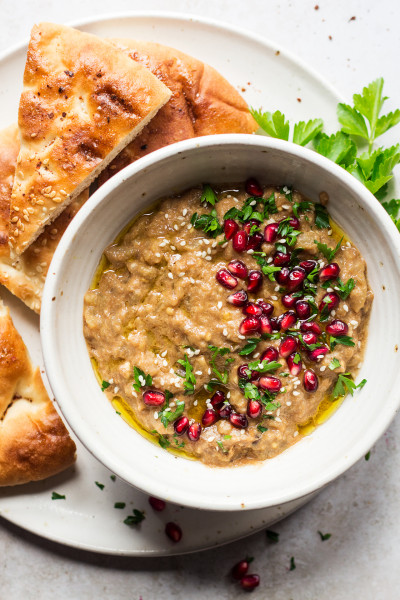
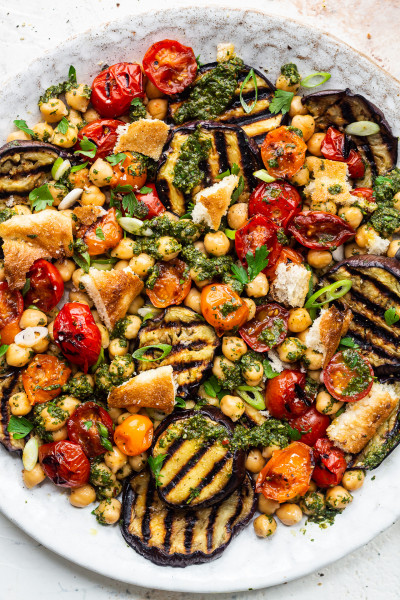
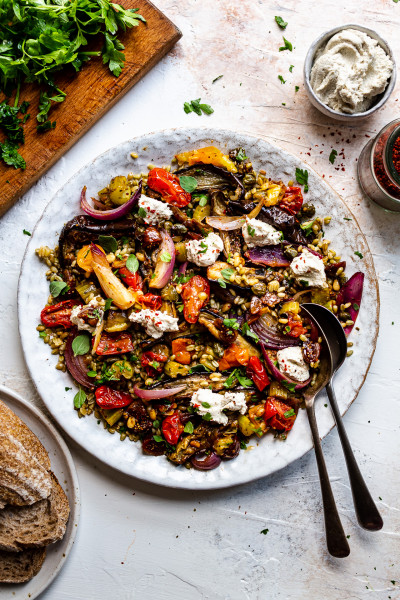
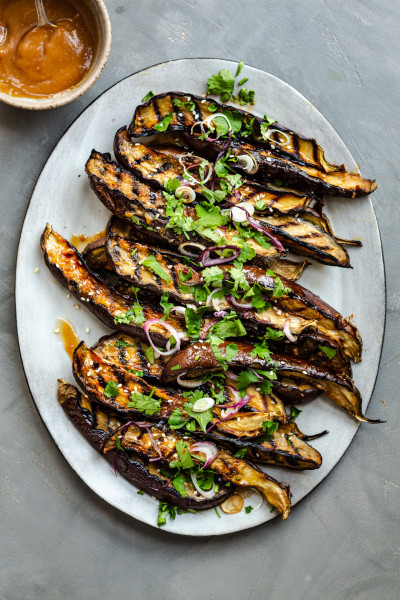
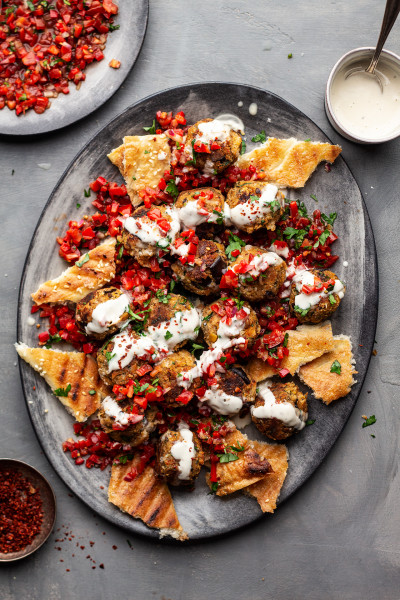
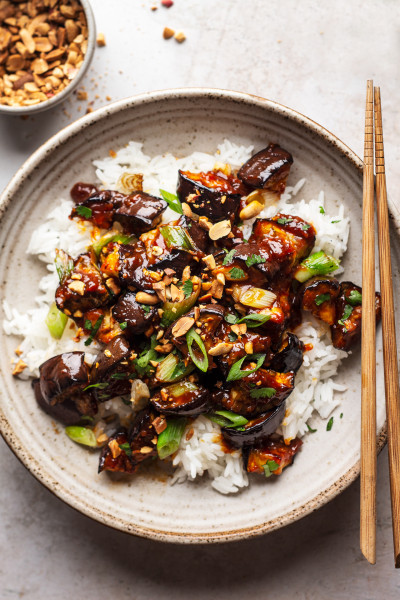
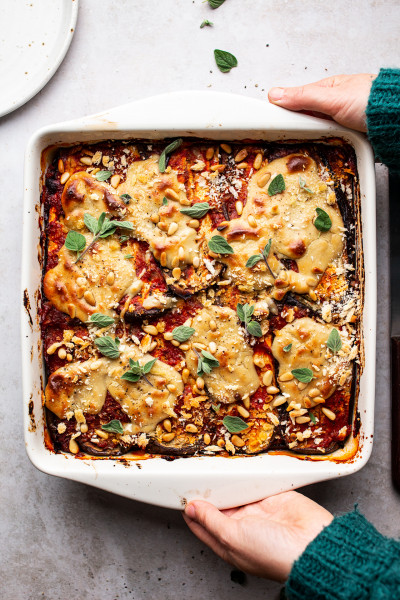


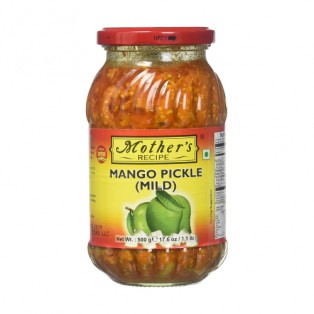
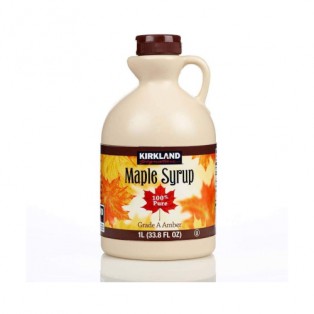
Being men, they didn't sample it delicately but shoveled it into their mouths.
I haven't tried, but I don't see why not. Ania
Wasn’t sure whether it was worth doing all the extras, but adds so much flavour.
Thanks for the blog!
It was steaming hot yesterday but I had already invited a bunch of people for dinner. I didn't feel like spending too much time bent over the stove and was looking for something that had a few fun elements that I could just put together. We don't get amba here, I didn't have parsley so subbed for fresh coriander, and I couldn't find pitas at the local grocer's but got piadinas instead, and, still, it was a stellar meal. We ended with sorbet, chilled wine and fruit.
I will definitely be making this again.
Thank you so much for sharing.
Thanks!
Lynsey
One of my sister's in law is Syrian, one Iranian, another is Iraqi , and my my mother-in-law is Egyptian and so the meals at their houses are spectacular.
All the semiotic peoples of the region have lived there for thousands of years and no one has claim over a chopped cucumber salad. Calling it Israeli is just fine. Food should unite.
I'm so glad you will try the recipe soon! It is called 'Isreali Salad' because this recipe is based on a recipe by Isreali chef Yotam Ottolenghi in his cookbook of Isreali food that is called Jerusalem (which is in Isreal). As we explained in the recipe, just about every Mediterranean country has its own version of the salad. BTW The dinosaurs span from the Triassic to the Cretaceous era which ranges from 250 million years BC to around 66 million years BC and humans only really originated 200 thousand years ago. There is a gap of approximately 55 million years between the dinosaurs and humankind, so I don't imagine people in the Middle East were sharing their salad with a Brachiosaurus no matter what it was called. Cheers!